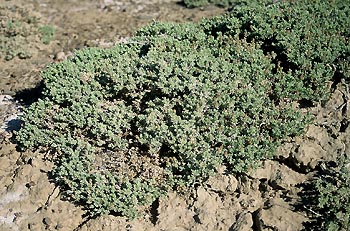Mat Saltbush

Common Name(s):
Mat Saltbush
Scientific Name:
Atriplex corrugata S. Wats.
Scientific Name Synonyms:
None known
Symbol:
ATCO4
Description:
Life Span: Perennial
Origin: Native
Season: Evergreen
Growth Characteristics: A short, mat-forming plant of ashen or soil color; woody at base. It can form mats 5 to 20 times wider than they are high. Prostrate branches often produce adventitious roots where they contact the soil. Mat saltbush flowers from April to early June.
Flowers/Inflorescence: The flowering stems, unlike the vegetative stems, are strictly erect and slender. The flowers are solitary or few, found in the axis of the leaf. The male and female flowers occur separately, but both occur on the plant. The male flowers are yellow to light brown. The female flowers are found on the elongated flowering stems that far exceed the leaves.
Fruits/Seeds: Fruit is a utricle.
Leaves: Thin, lance-shaped blades, with white hairs. Leaf arrangement mostly opposite, but alternate at the top of the stems.
Stems: Decumbent. The white bark is thick and spongy, shreddy on older trunks.
Ecological Adaptions:
Occurs on mancos shale hillslopes, ridges, footslopes, knolls, and toeslopes of undulating plateaus, at elevations 4,000 to 7,000 feet. Where it occurs, it is usually the dominant plant species.
Soils: Moderately deep and deep alkaline or saline soils.
Associated Species: Alkali sacaton, Indian ricegrass, bottlebrush squirreltail, gardner saltbush, shadscale, and desert trumpet.
Uses and Management:
Mat saltbush is valuable forage for livestock and wildlife. It is grazed by sheep in the summer and fall after other forage has been used or has dried up. Poisoning may result when little else is eaten.

